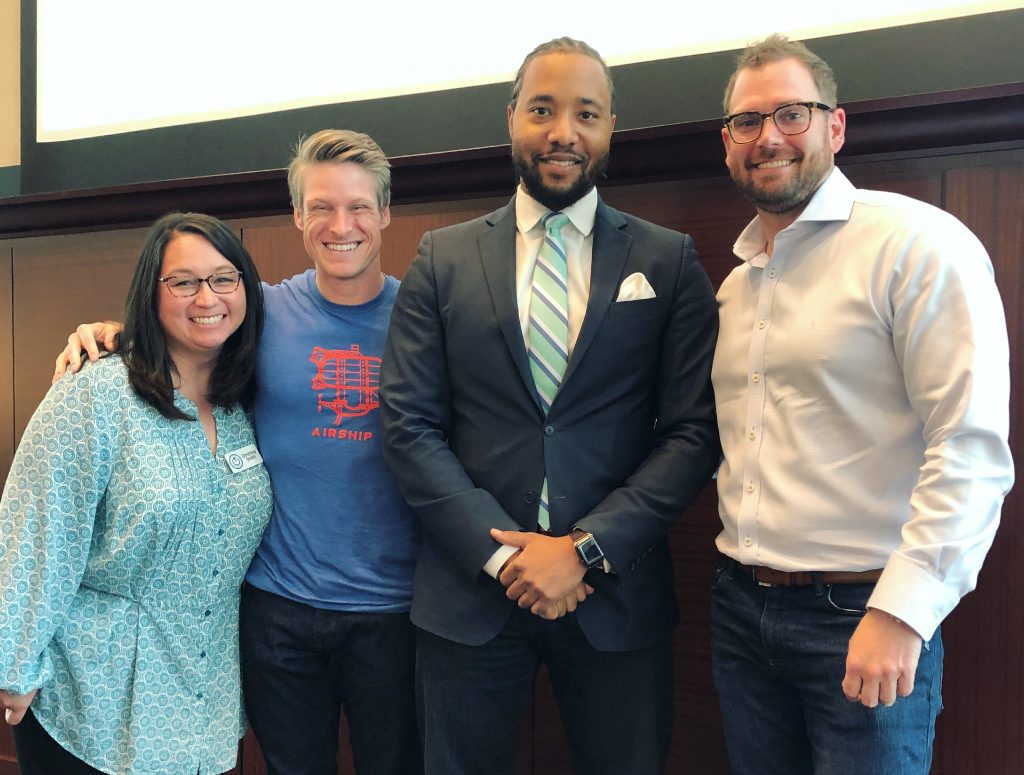Here to hear @teamairship talk intentional culture. Thanks @techbirmingham pic.twitter.com/8ScJEQEWWt
— jessicavance (@jessicavance) May 15, 2018
Defining intentional
The ideas being presented to build an engaging company culture are not revolutionary. The difference is intentionality. The definition of intentional is done on purpose, or deliberate. This is the critical piece. Being intentional in all you do is easy in concept, but difficult in practice.Defining culture
Boiled down, culture is the cumulation of individuals with different traits that work in unison to move a company’s vision forward. We do not look for people who fit into a predefined set of skills alone. We look for people who believe in our "why."A full house at @techbirmingham #TechTuesday to listen to @teamairship co-founder @trentkocurek talk about “Why.” #leadership #culture pic.twitter.com/IvLuIid3Yd
— Dave Gray (@DaxkoDave) May 15, 2018
Defining your "Why?"
One of our favorite quotes is from Simon Sinek in his book, Start with Why: "Average organizations give their people something to work on. Great organizations give their people something to work toward." Your "why" is the shared beliefs and passions for why your organization exists. It doesn't have to be one thing - it can be many. And it can be emotional - running a business is an emotional journey, so put some feelings into it! Ask your team what they think - what do they love about their position? Do you notice any patterns in their feedback? Once you define your "why," put it in a place where everyone can see it. Documenting our shared beliefs and passions for Why Airship exists was a very important task for a few reasons:
Your "why" is the shared beliefs and passions for why your organization exists. It doesn't have to be one thing - it can be many. And it can be emotional - running a business is an emotional journey, so put some feelings into it! Ask your team what they think - what do they love about their position? Do you notice any patterns in their feedback? Once you define your "why," put it in a place where everyone can see it. Documenting our shared beliefs and passions for Why Airship exists was a very important task for a few reasons:
- It allows us to approach difficult decisions with clear goals in mind.
- It allows for more autonomy within your team because everyone has questions to ask themselves when making a decision.
- It helps in hiring, millennials especially, given that most want to work for a company that has an underlying mission.
- It’s the INTENT in Intentional that we are talking about today.
Listening to our good friend @trentkocurek from @teamairship talk about being intentional about company culture at @techbirmingham #techtuesday. pic.twitter.com/jFP6xcEaNW
— QuantHub (@QuantHub) May 15, 2018
Hiring
"People are not your most important asset. The right people are." - Jim Collins, Good to Great At Airship, we strongly believe that new hires must be a good culture fit. No matter how much we may need their skills at the moment, we do not hire them if they do not agree with our Why. We look for alignment with our Why, passion, drive, and grit, then we interview for skills. Make your interview questions correlate with your Why. As our Opportunity Explorer Lead Luke Richardson puts it, “Passion is a necessity for skills to be properly applied.” Hire people that fill gaps in your team, set of skills, and personality traits. Your entire team should be diverse with everyone agreeing on your Why. To do this, you must understand the personality traits on the team (we use Culture Index) to see what's missing. This also creates more understanding for people who interact together often. Then you can define what traits are needed for a role. And always hire people who are smarter than you.Be very transparent in the hiring process (and in the job posting). Tell them what they're getting into up front and don't waste anyone's time. Here's an example of what we promise to those that come to work at Airship.“I get so excited when I hire someone smarter than me” -@trentkocurek @teamairship #TechTuesday @BurrForman
— TechBirmingham (@techbirmingham) May 15, 2018
Firing
Letting people go is never easy, but neither is regaining trust from a team that you allowed a bad fit to stay in. Before letting anyone go, we first see if they would be better in a different seat. This is not always possible, sometimes there are no open seats. For those having to make this decision, a few tips have helped with my approach:- We know a person that is not a fit for your company could be an A player at another company. It’s not fair for them or your other team members to keep them there.
- We think of our entire team instead of focusing on the individual alone.
- We are fully transparent about our decision and why.
Trusting
“Trust doesn’t mean that you trust that someone won’t screw up – it means you trust them even when they do screw up.” - Ed Catmull Trust is crucial to a company’s growth. You do not have time to make every single decision. We empower people to make decisions - they are smart and understand our Why, that's why we hired them. Another great quote from Ed Catmull in Creativity, Inc. is “What is the point of hiring smart people, we asked, if you don’t empower them to fix what’s broken?” - Ed Catmull Some ways we trust our team:- Navigators work with the builders to set the project management process.
- Builders choose the times of day they work that is most productive to them.
- Explorers can negotiate price points to get a deal agreed upon.
Action items for building trust with your team:“We empower our people to make Good decisions” -@trentkocurek from @teamairship #TechTuesday sponsored by @BurrForman
— TechBirmingham (@techbirmingham) May 15, 2018
- Delegate decision making to your team. Allow them to define their processes.
- Give support and critique along the way.
- As leaders, make your screwups a little more public to garner trust. Apologize and say aloud what you’ve learned from it.
Inspiring
Inspired people inspire others. We do our best to teach people how to find wins in their day-to-day. If they are goal oriented, help them structure their tasks in a way that plays on that. If they are team-oriented, make sure they see how their work fits into the success of the team.One great way to inspire your team is with weekly one-on-one meetings. Be honest and direct with performance. Give criticism when it's due. Praise privately but also leave some praise for public display. We like to publicly praise people as much as possible, such as in our weekly team meetings. Most importantly, get your people in front of a customer. Seeing the hard work impact someone in a positive way is the best way to inspire someone to enjoy the best times and push through the difficult ones.“Inspiring someone is different than motivating them. You shouldn’t have to motivate your team” - @trentkocurek from @teamairship #TechTuesday sponsored by @BurrForman
— TechBirmingham (@techbirmingham) May 15, 2018

Growing
“Craft is what we are expected to know; art is the unexpected use of our craft.” - Ed Catmull
We are a team of passionate learners who believe you must make "getting better" a central part of your company culture if you want to grow. On our team, we do this by providing our team members with access to conferences, purchase books and Udemy courses, provide dedicated 10% learning and growth time each week, and conduct weekly learning meetings where we teach each other something new. Prioritizing health is also vital to growth. Healthy minds need exercise which is why we offer a gym reimbursement and have flexible schedules. We also consider career growth for our individual team members. We don’t assume that everyone on the team wants to move into management. Far too often this is the default “promotion” path. We try and understand our crew members' goals. Some people want to be amazing project navigators and developers all their lives. Make sure they have a success path, too.Action Items for being intentional with Growth:Cheers to #TechTuesday @teamairship @trentkocurek sponsored by @BurrForman pic.twitter.com/8gM5CfXD32
— TechBirmingham (@techbirmingham) May 15, 2018
- Set aside some money to invest in the personal and professional growth of your team and MAKE them use it.
- Offer some type of health benefit
- Healthy snacks
- Walking trails
- Team hikes
- In your one-on-ones, find out what your crew’s true professional goals are.


